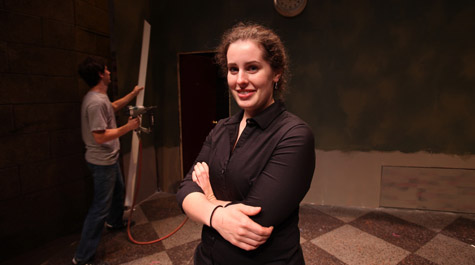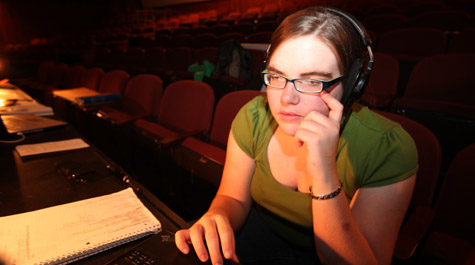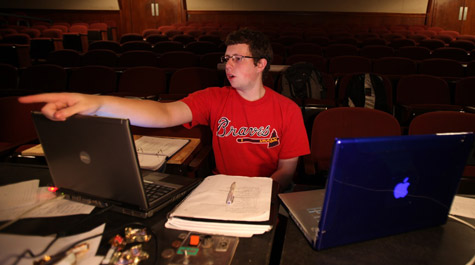Student designers 'create the world'
"I was like, wait, that's my wall," she said. "I just drew that wall."
Inglis was one of a handful of William & Mary students who approached the theatre department last year and asked if they could serve as the designers for one of the College's main stage productions.
Next week, their work comes to fruition when the William & Mary production of "Little Shop of Horrors" opens. The musical runs Nov. 13-14 and 19-21 at 8 p.m. and Nov. 15 and 22 at 2 p.m. in Phi Beta Kappa Hall.
"I always think of it as the designers create the world and the actors populate the world," said Inglis, who is the set designer for the show. "We need to make a world that feels real, and feels like this could actually happen because otherwise the actors and their performances are diminished because there's not a match there."
Along with Inglis, David Moody and Christy Sexton are also serving as designers for the show. Moody, a senior majoring in theatre and computer science, is the lighting designer. Sexton, a senior majoring in government and minoring in math, is the sound designer.
Joan Gavaler, chair of the department of theatre, speech and dance, said that it's very unusual to have so many student designers working on a single show.
"But we have a rich crop of seniors this year, and it's wonderful to see them take on a big project like Little Shop," she said.
The trio of seniors said that once they got the green light from the department, they all started their respective creative processes with the same thing: the script.
For Sexton, it was a matter of both finding out when the actors, who are using microphones, would be speaking and what sound effects and recordings would be needed.
"Sound is a pretty simple process in that you break it down, you find all the sound effects that are needed in the script," said Sexton. "So, for instance, there's a thunderstorm so I write down, ‘Need thunder. Need rain.'"
Moody searched the script for something a little less tangible.
"You go in and you're trying to isolate this odd thing called mood," he said. "You try to not look at the script as just, oh I need a cue here."
Moody instead created a breakdown for each scene, describing where each takes place, whether it's opened or closed and his thoughts on mood. He keeps the scene breakdowns in a large binder so he can refer to them at any time.
"The paperwork for me is to remember what happens in each scene in any moment so I can go back through things and figure out what color and what sort of look I want for each section. I can just look at that and say, oh look, so this is what I was thinking," he said.
Inglis, too, examined the script for information on when and where the scenes take place as well as their moods.
"So I started by doing an image search, looking at photos of New York City from the 1960s and Chicago and trying figure out how do I get the essence of a city on stage without building a city," said the economics and theatre major.
In addition to designing sets that would show both the inside and outside of the title shop, Inglis also had the task of finding or creating one of the show's main characters: the plant. She realized quickly that they did not have the time, resources or space to build the plant puppet, so she decided to rent it.
While Inglis worked on sets, Sexton was figuring out how to create the sounds that were needed for the show, including the thunderstorm. Though it seems like she could have just picked a sound effect from a database, it's more complicated than that, she explained.
"In thunderstorms, you have to piece together the wind, the rain, the thunder rumbles," she said. "You have to figure out how to build these sound effects because you won't be able to just pull from a sound database ‘thunderstorm' and have it be exactly what you want."
For the show's lighting, Moody worked off of a concept statement.
"It's what you see for the show and what kind of commentary you are trying to show with your design and then coming up with images and metaphors for what each location is and what each location means and what each character means and how that affects the world of the show," he said.
Using that, he designed the lighting to help shape each scene. Moody said that often lighting in theatre is not like lighting in a rock concert -- meant to be noticed.
"A lot of the time, it's really the subtle things like reinforcing the theme through the choice of a color that the audience may not even notice or highlighting a character with a subtle shift," he said.
Sexton added, "Lighting has a lot of things that you don't actively notice but affect you nonetheless. Like a character will enter and you become really angry and you don't know why. It's the lighting design."
Throughout the creative process, each of the designers constantly consulted with one another, the costume designer and the show's director to ensure that everything would work together appropriately.
"A huge part of the responsibility that I hadn't realized before is keeping in touch with everybody and keeping those conversations going," said Inglis. "It's very easy to get caught in your own world in the design studio and just draw and draw and draw and forget that everyone else is influenced by this and they probably have very important ideas that I need to be hearing, too. Keeping the conversation running takes a lot of time but is worth it."
Along with collaborating with each other, the students have worked closely with faculty members throughout the year, including director Christopher Owens, musical director Gary Green, choreographer Denise Wade, costume designer Patricia Wesp and technical director Dave Dudley. The students have also been guided by their faculty advisors: Jennifer Griffin for Moody, Matthew Allar for Inglis, and Dudley for Sexton.
"All of these faculty and staff are working together to create the infrastructure for these students to directly test the knowledge and abilities they've been developing for the past four years," said Gavaler. "William and Mary is unique in offering production opportunities for undergraduates with such a high degree of responsibility."
The students said that the opportunity to design a show themselves has been invaluable.
"It's fun to see how each of the designs changes and have all of us at a phase where we're still learning about ourselves as designers and see how that changes and how that influences the design as it comes out," said Moody, who is also writing a senior honors thesis about his experience and research for this production.
Inglis said she now has a greater understanding of what a set designer does and just how "huge" the job is.
"Just having the ability to create something from scratch is very exciting and very full of responsibility," said Inglis. "I've definitely enjoyed getting to create my own set, getting to paint it, getting to look at it and just kind of seeing my designs be realized is teaching me a lot."
Sexton said the process reminded her of when she put a new screen door on her house.
"You know what you need to do, you know what the finished project is going to be," she said. You just have to figure out what you're using to get there, where it all is, how to put it all together in the right way and have it work as a part of the whole."
Despite months and months of preparation and hard work, the designers know that the audience may not overtly notice their handiwork.
"Performance from a designer's standpoint means something completely different than from an audience's standpoint," said Moody. "When they talk about a character's choice, that invariably related to a choice you made, too, somewhere. So it's all tied together somehow."
Sexton added, "If (the audience) doesn't notice us, then we're doing our job."
With that in mind, the student designers look forward to opening night, when their world is revealed for all to see.
"When you get to that opening and everything's done and you get to see an audience's reaction to it, that's what really makes it all worth it," said Moody.


















